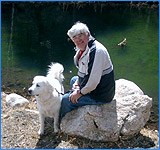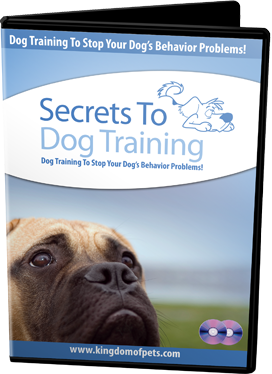If you are looking for the greatest gold-mine of easy to use "change your dog's behavior" advice ever crammed into a newsletter series then read on!
Also, make sure that you check out our 100% authentic testimonials from people who have bought Secrets to Dog Training and find out the massive difference it has made to their owner-dog relationship!
 "Hi, I bought the online book Sit Stay Fetch, because I have a big Guardian dog, and she was very aggressive to strangers in our house. I knew she could be trained because her mother was not aggressive. I got several good tips from the book as well as a personnel email on how to correct her behaviour. It worked and she is now much much better. I am very pleased and satisfied I bought the book. Thanks a bunch Daniel for doing what you do."
"Hi, I bought the online book Sit Stay Fetch, because I have a big Guardian dog, and she was very aggressive to strangers in our house. I knew she could be trained because her mother was not aggressive. I got several good tips from the book as well as a personnel email on how to correct her behaviour. It worked and she is now much much better. I am very pleased and satisfied I bought the book. Thanks a bunch Daniel for doing what you do."
-- Doug Cummins (Nebraska, USA)
Dear Daniel,
Our Puggle puppy, Tiger, bites and nips all the time at our clothes and even our body parts. He is a very hyper dog and will play 24 hours a day. We have two kids and I feel he does not do this because he is mean or anything. We have tried the can with pebbles, spray bottle, staying no loudly, ignoring him, giving him a time out but he will still do this, it's almost like he has to be always playing. If you sit on the floor and play with him for hours he will not bite or nip you. We have done all the alpha tips in the book as well, as he does sit when you tell him to and we are working on the others.
Karl
Hi there Karl
Thank you for your email regarding your 6 month Puggle, Tiger. It's not always easy to convince a new puppy not to bite the hand that feeds him . . . pets him . . . or plays with him, for that matter. When puppies play with each other, they use their mouths, so they may also be inclined to bite or "mouth" your hand during play or when being petted. This is rarely aggressive behavior meant to do harm, but it is a difficult habit to break unless you encourage your puppy to try an acceptable alternative behavior. The goal is to redirect your puppy's energy onto acceptable chew toys, and to teach her to be gentle when a hand is in or near her mouth.
Encourage Acceptable Behavior
Redirect your puppy's penchant for nipping and biting by offering him more acceptable objects (such as chew toys) whenever you pet him. This technique can be especially effective when children want to pet him. As you or the child reaches out to scratch him behind the ears with one hand, offer the chew toy with the other. This will not only help your puppy learn that people and petting are wonderful, but will also keep his mouth busy while he's being petted. Alternate which hand does the petting and which one has the chew toy. You may need to start off by petting or scratching your puppy for short periods of time, since the longer he's petted, the more likely he is to get excited and start to nip.
Discourage Unacceptable Behavior
You must also teach your puppy to be gentle with hands, and show him that nipping results in unpleasant consequences. Teach your puppy that nipping "turns off" any attention and social interaction with you. As soon as a nip occurs, look your puppy right in the eye and yell "OUCH" as though you've been mortally wounded. Then ignore her. Leave the room if you must, but ignore him until he's calm, and then try the chew toy and petting method again.
Jumping Up
When your puppy jumps up on you, he wants attention. Even if you push him away, he is still getting attention (even if it is a response that you might consider negative).
When your puppy jumps up:
Fold your arms in front of you, turn away from him, and say "off."
Continue to turn away from him until all four paws are on the ground, then quietly praise him and give him a treat. If he knows the "sit" command, give the command when all four paws are on the ground, then quietly praise him and give him a treat while he's in the sitting position.
If he begins to jump while you're praising him, simply turn away and repeat the second step, above.
Remember to keep your praise low-key.
When your puppy realizes that he gets no attention from you while he's jumping up, but does get attention when he sits, he'll stop jumping up. Remember, once you've taught him to come and sit quietly for attention, you must reward his behavior. Be careful not to ignore him when he comes and sits politely, waiting for your attention.
What Not to Do
Attempts to tap, slap, or hit your puppy in the face for nipping or jumping up are almost guaranteed to backfire. Several things may happen, depending on your puppy's temperament and the severity of the correction:
Set boundaries when playing "tug-of-war" or wrestling games with your puppy. When trained properly, these types of games can teach your puppy bite restraint and the limitations of rough play.
Be Consistent
It's important that all behaviors, acceptable and unacceptable, be managed consistently by all family members. And remember that any method you try will probably not be effective unless you work hard to teach your puppy an acceptable alternative behavior.
A Note About Children and Puppies
It's very difficult for children under eight or nine years old to practice the kind of behavior modification outlined here. Children's first reaction to being nipped or mouthed by a puppy is to push the puppy away with their hands and arms. This will be interpreted by the puppy as play and will probably cause the puppy to nip and mouth even more. Adults should closely monitor all interactions between their children and dogs.
I hope that these suggestions help you. It will take some time to work so don't expect too much of your puppy straight away.
Best of luck with your training,
Kind regards,
Daniel Stevens and the Secrets to Dog Training Team
"Secrets to Dog Training - STOP Dog Behavior Problems!"
 I've been a professional dog trainer for well over 20 years, and in that time I've helped thousands of dog owners just like you to get the friendly, well behaved, slipper fetching, best pal they always wanted.
I've been a professional dog trainer for well over 20 years, and in that time I've helped thousands of dog owners just like you to get the friendly, well behaved, slipper fetching, best pal they always wanted.
But it didn't start out that way. I've always loved dogs, some things never change. But when I first started my professional dog training career I relied on the so-called 'best practices' when it came to dog behavior training. It was only when I heard people tell me over and over again that they just weren't seeing results that I started to question the old accepted wisdom. So I started a journey, a quest to search out the best, most effective, techniques, tips, and tricks that really work.
And that's how I came up with Secrets to Dog Training. Year after year I found new techniques that achieved the results I wanted. Eventually I had a whole book worth of great resources: Secrets to Dog training...
So, if you want to:
Then Secrets to Dog Training is just what you've been looking for!
Previous newsletters
| 01 | 02 | 03 | 04 | 05 | 06 | 07 | 08 | 09 | 10 | 11 | 12 | 13 | 14 | 15 | 16 | 17 | 18 | 19 | 20 | 21 | 22 | 23 | 24 | 25 |
| 26 | 27 | 28 | 29 | 30 | 31 | 32 | 33 |34 | 35 | 36 | 37 | 38 | 39 | 40 | 41 | 42 | 43 | 44 | 45 | 46 | 47 | 48 | 49 | 50 |
| 51 | 52 | 53 |54 | 55 | 56 | 57 | 58 | 59 | 60 | 61 | 62 | 63 | 64 | 65 | 66 | 67 | 68 | 69 | 70 | 71 | 72 | 73 |